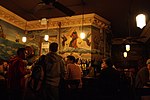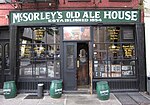Daniel LeRoy House

The Daniel LeRoy House is located at 20 St. Marks Place in the East Village neighborhood of Manhattan in New York City. The Greek Revival building was built in 1832 as part of a development by Thomas E. Davis of 3½-story brick houses which spanned both sides of the street. The Daniel LeRoy house is one of the three surviving houses of this development, the other two being 25 St. Marks Place and the Hamilton-Holly House at 4 St. Marks Place. It has a marble entrance ornamented with vermiculated blocks. LeRoy was an in-law of Peter Stuyvesant, and a South Street merchant, who lived in the house with his wife Elizabeth Fish, of the eminent Fish family. The building was designated a landmark by the New York City Landmarks Preservation Commission in 1969, and was added to the National Register of Historic Places on October 29, 1982. In Spring 1998, restorations were made on the house, including repainting, repointing brickwork and replacing cornices.
Excerpt from the Wikipedia article Daniel LeRoy House (License: CC BY-SA 3.0, Authors, Images).Daniel LeRoy House
East 7th Street, New York Manhattan
Geographical coordinates (GPS) Address Nearby Places Show on map
Geographical coordinates (GPS)
| Latitude | Longitude |
|---|---|
| N 40.728611111111 ° | E -73.988888888889 ° |
Address
East 7th Street 31
10003 New York, Manhattan
New York, United States
Open on Google Maps







